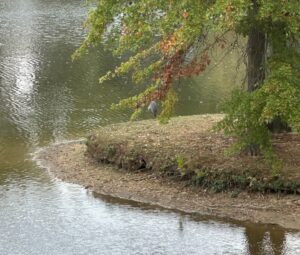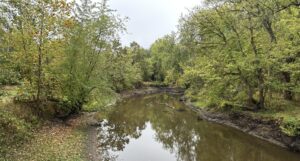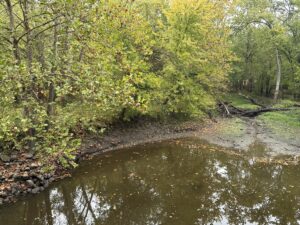Birds and weather ……..
As you know, Cleon and I live in central Illinois. What you might not know is we have been in a drought since the beginning of July. According to the Illinois State climatologist, the area where we live is on the border between ‘severe’ and ‘extreme’ drought.
We are fortunate that our daytime temperatures have decreased. Throughout September, our daytime temperatures remained in the high 80’s-mid 90’s. Two days ago, it was 79 degrees in the afternoon which is still too warm for October here in our county. Night-time temperatures have been widely varying – anywhere from the high 50’s to as low as 38. There is no chance of frost – or dew – as our air is quite dry.

According to the Illinois State Climatologist Office, all of central Illinois has seen anywhere from an 8-15 inch drop in rainfall since June 30th. One of the large lakes which is about 30 miles from us is now 2.4 feet below normal level and the city surrounding it – population between 80,000 and 90,000 – has asked its citizens to voluntarily conserve water as the lake continues to drop.
The soil everywhere in our county is absolutely dry – even if you dig down past a foot and a half or more. There is no dampness or moisture anywhere. And it is no longer possible to dig into the soil without a whole lot of muscle – it feels like we are trying to dig into our cement sidewalk when we try. Instead of a shovel, a jackhammer would be a better choice.
Our gardens, trees, and shrubs are suffering. When something happens to your yard – like this drought for us – it is necessary to look at each section of your yard and gardens carefully, because soil – and therefore the behavior of your plants – is different throughout your space. This is why if you take a soil sample, you are always instructed to take soil from several places. Light and heat also vary – even from small area to small area. There are a few places in our yard where the shrubs and trees are holding their own. This could be for several reasons. We have a high water table throughout Illinois. We are on a well here at our house which is only about 50 feet deep – a big difference from the well we had when we lived in West Virginia which was 425 feet deep. Depths of water tables can vary – even within a neighborhood. And there could be places in our acre where the water table is a bit higher than 50 feet and our big trees’ roots have accessed it – or at least the damp soil above it. And we do have areas in our yard that are shaded by the house and garage from the hot afternoon sun so the soil and all the plants that are planted there do not get as hot. A cooler soil will conserve more moisture and many plants that thrive in central Illinois like a cooler soil. Shade helps. And in a prolonged drought – or unseasonably hot temperatures – this is where you will find the most wildlife: insects, birds, amphibians, reptiles, small mammals.
We are also fortunate that we live on a lake. Although the levels in our lake are dropping about the same as the large lake near us, we do pump water from the lake to water our most vulnerable plants. And we do not use overhead sprinklers or soaker hoses. We use a hose and water wand to water each plant individually. Doing this allows us to water deeply, but not waste water on plants that do not need to be watered, or to have the water evaporate before it ever hits the soil. And we are mulched which helps the soil stay cooler and conserve water.
Some of the rivers in Illinois are in what is termed ‘low flow’ or ‘no flow’ stage. This means that the water is moving much more slowly than normal – or not moving at all. The Vermillion and Sangamon Rivers are listed as being at almost no flow stage right now. We live near the Little Sangamon which flows into the Sangamon. This is a narrow river, but right now it looks like standing water in a muddy ditch. There has been no flow in the Little Sangamon for several weeks – it is also now an unconnected river in that some parts are totally dry – hence the no flow.
This is all expected to worsen in the coming weeks. If we get little or no rain, what will help is cold weather – trees, shrubs, and perennials going dormant. According to predictions from climatologists – and The Farmer’s Almanac – we will have a drier than normal winter and spring, but a wetter summer. Summer begins June 21st – a long time from now.
So what does this mean for our backyard birds and also birds coming through in migration?
If you have been watching the livestream, you will have noticed a big drop in the number of birds using the feeders and the bird baths – this became noticeable at the beginning of September. Some of this is seasonal. We always experience a noticeable decrease in the number of birds in our yard in September and October. The juncos and the wintering sparrows generally arrive some time in late October-early November, and then there is much more activity as all these birds will use the feeders several times a day and each day. But those birds come from up north – the most northern parts of our northern states and Canada – and with our warmer temperatures, it is hard to predict when they might actually arrive – or even if they will arrive. Several years ago we had an entire winter season without one junco in our yard – a sad winter for us. Luckily, they all returned the following year and have been with us ever since.

Our county, and especially the land within about a five mile radius of our house, is full of wetlands. Some are quite large. The Little Sangamon River reliably overflows its banks every spring – sometimes the water in the surrounding woodlands and grasslands can be several feet deep. And it is always slow to recede. Even throughout the entire summer, these are generally quite marshy areas. Not farmable and certainly no houses can be built. All of this is now totally dry. There is no mud for migrating shorebirds like all the sandpipers and plovers. The large areas of shallow, pooled water for migrating dabbling ducks like Northern Shovellers and teals are completely dry. And in these vast marshy areas, plants have been dormant since early to mid-September which means the insects have mostly disappeared. Normally, we can hear them as

we drive by – it has been silent for weeks. This means there are fewer insects available for migrating songbirds. Normally these plants do not go dormant until late October-early November when insects either are in the ground, within plants for wintering, or their life cycle is over. Migration is also just about over at that time. Everything always fits together in nature.
Our resident birds are still here. If you watch the feeders and birdbaths – most especially in the mornings until about 9:30AM Central Time, and again, beginning about 4:30PM, you will see birds. We still have a good number of Blue Jays. Our Eurasian Tree Sparrows have not returned and with them gone, we now have an increasing number of House Sparrows – families that often come to the feeders and bird baths together (for more information on these two birds, here are two links: Eurasian Tree Sparrows and Eurasian Tree Sparrows and House Sparrows – Similarities and Differences. House Finch families are still here, and you will see more White-breasted Nuthatches and Tufted Titmice. We still have Downy Woodpeckers, at least one Hairy Woodpecker, and some Red-bellied Woodpeckers. Our mated pairs of Northern Cardinals will appear at the feeders at dawn and as the sun goes down. We did get a large flock of blackbirds – as we always do – that came and roosted in our trees. Only several came to the feeders – the rest stayed at the treetops. Normally they are with us for about three weeks and then move on. This year, they were here only four days before they disappeared. This flock is mainly Common Grackles, but there are generally a few Brown-headed Cowbirds and Red-winged Blackbirds mixed in. We also always have crows in our yard almost every day from late August through October, and then off and on throughout the winter. This year we had one or two sporadically in early September and have had none since.
We have been thrilled to see Eastern Bluebirds coming to both bird baths in the late afternoon. Most often, we are seeing two males and one female – and all three come together. This is unusual for us. We do have bluebirds from time to time in our neighborhood, but for some reason, rarely in our yard. This year is an exception – and we love to see them.
Drought is not good for anyone. Besides the fact that all of us human beings who live around this small lake have wells, there is less for birds, amphibians, reptiles, and mammals to eat. There are not as many insects, and plants are going dormant much earlier – or they are dead. And we noticed that although we do have a lot of nuts falling from our oaks and hickories, they are smaller than normal.
But the upside at the feeders and bird baths is that when birds are present, because they are fewer in number, we all get to watch each bird for a longer time and to get more of an idea of its movements and behavior. Especially the nuthatches and titmice who tend to avoid the feeders when there are a lot of birds using them. It is a relaxing time for the birds!
P.S. I generally take several days to write my blog. I am not like the bloggers portrayed in Hallmark movies who type out their blogs and immediately post. I need to do rewrites and much editing. We did have a day of rain yesterday – and it was exactly in the form needed. Slow and gentle. Our rain gauge measured about an inch. Had the rain been hard and heavy, the ground would have never absorbed it. This slow rain certainly helped all the trees, shrubs, and perennials in our yard, but only put a small dent in our ongoing drought. And unfortunately, from this morning through Wednesday, we are going to have sustained high winds – that will dry everything out quickly. Our temperatures remain too warm – we are still going to average in the low 60’s during the day. Historically, the average temperature for October is closer to 56 degrees. To quote Yogi Berra, “It ain’t over til it’s over.” And our drought is far from over.

